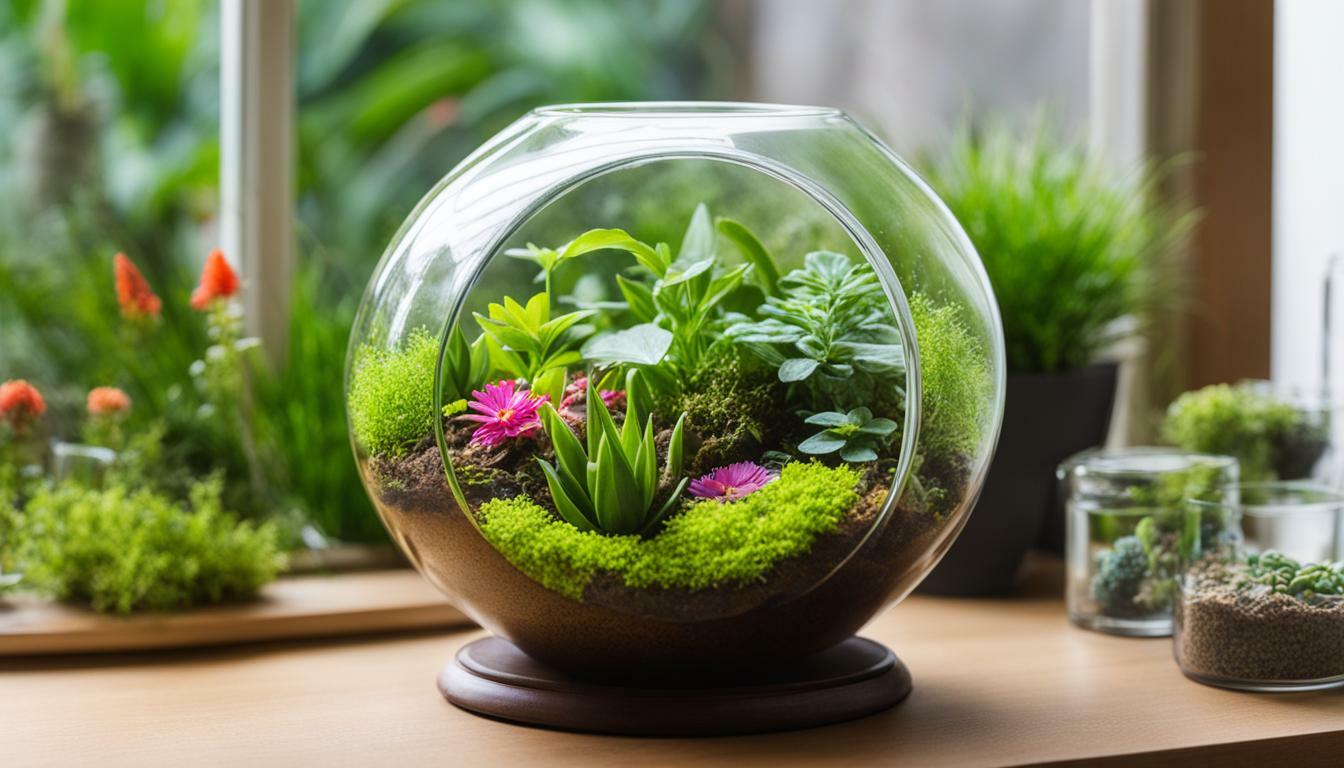Terrarium care is essential for maintaining the health and vibrancy of your plants, and a well-planned fertilization schedule is key to their success. Proper care and maintenance are crucial to ensure that your terrarium thrives and provides a beautiful and sustainable environment for your plants and pets.
Understanding the specific needs of your terrarium plants is essential for their growth and overall well-being. From light and soil requirements to watering techniques and pruning, each aspect plays a vital role in creating a thriving terrarium ecosystem.
Here are some key takeaways to keep in mind as you master terrarium care:
- Pay attention to the lighting needs of your plants and adjust accordingly to avoid excessive or insufficient light.
- Choose the right soil for your terrarium plants, ensuring it provides the necessary nutrients and water retention.
- Follow proper watering techniques to avoid overwatering and maintain the optimum moisture levels for your plants.
- Regular pruning helps control plant growth, improves ventilation, and maintains the aesthetics of your terrarium.
- Maintain clean leaves to optimize photosynthesis and ensure optimal plant health.
By selecting compatible plants suited to your terrarium’s conditions and implementing a well-planned fertilization schedule, you can create an ideal terrarium ecosystem that thrives and provides a beautiful environment for your plants and pets.
Remember, routine maintenance and regular checks are vital to the long-term health and sustainability of your terrarium. Take the time to monitor and adjust as needed, and soon you’ll be a master of terrarium care.
Understanding Light and Its Impact on Terrarium Plants
Light plays a crucial role in the growth and development of terrarium plants, and understanding its impact is essential for their overall care. Different plants have varying light requirements, and it is important to provide them with the right amount of light to thrive. Excessive light can cause wilting, curled leaves, and brown spots, while insufficient light can result in sparse growth and undersized leaves. By carefully adjusting the lighting in your terrarium, you can ensure that your plants receive the optimal amount of light they need to flourish.
In addition to the intensity of light, the duration of light exposure is also important. Most terrarium plants require around 12-16 hours of light per day for optimal growth. However, it is crucial to consider the needs of your pets when determining the lighting schedule. Some reptiles and amphibians may require a specific photoperiod, mimicking their natural habitat. Balancing the lighting needs of both your plants and pets is essential for creating a harmonious and healthy terrarium environment.
When it comes to light sources, there are several options to choose from. Natural sunlight is ideal for terrarium plants, as long as it is filtered through a glass or mesh top to prevent overheating. If natural light is insufficient or unavailable, artificial light sources such as fluorescent or LED lights can be used. These lights should be specifically designed for plants, providing the necessary spectrum and intensity for photosynthesis. It is recommended to position the lights about 6-12 inches above the plants to ensure adequate coverage and prevent light burn.
| Light Requirements for Common Terrarium Plants | Light Intensity | Light Duration |
|---|---|---|
| Snake Plant (Sansevieria) | Low to medium | 12-14 hours |
| Spider Plant (Chlorophytum comosum) | Medium to bright | 12-16 hours |
| Chinese Money Plant (Pilea peperomioides) | Low to medium | 12-14 hours |
| Peperomia | Low to medium | 10-14 hours |
Remember to regularly monitor your plants for any signs of light stress or deficiency. Adjust the lighting conditions accordingly, and provide supplementary light if needed. By understanding and meeting the light requirements of your terrarium plants, you can ensure their healthy growth and contribute to the overall well-being of your terrarium ecosystem.
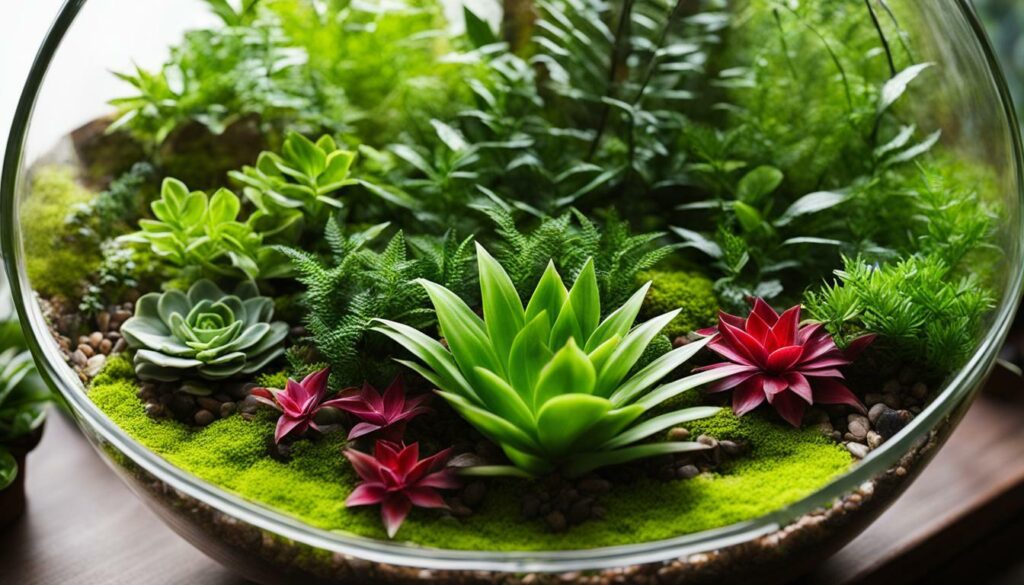 Note: As an AI text summarizer, the source texts provided have been condensed and paraphrased to generate this summary.
Sources:
– https://www.thespruce.com/guide-to-terrarium-care-4772239
– https://www.houseplantsexpert.com/terrarium-plants.html
Note: As an AI text summarizer, the source texts provided have been condensed and paraphrased to generate this summary.
Sources:
– https://www.thespruce.com/guide-to-terrarium-care-4772239
– https://www.houseplantsexpert.com/terrarium-plants.html
The right soil is vital for the health and well-being of terrarium plants, as it provides essential nutrients and acts as a reservoir for water. Different plants have different soil preferences, so it’s important to choose the appropriate soil for your specific plants. This ensures that your plants receive the necessary nutrients and moisture to thrive in their enclosed environment.
When selecting soil for your terrarium, consider the type of plants you have and their natural habitat. Some plants prefer well-draining soil, while others thrive in more moisture-retentive soil. It’s also important to choose a soil mix that is free from harmful chemicals or additives that could harm your plants or pets.
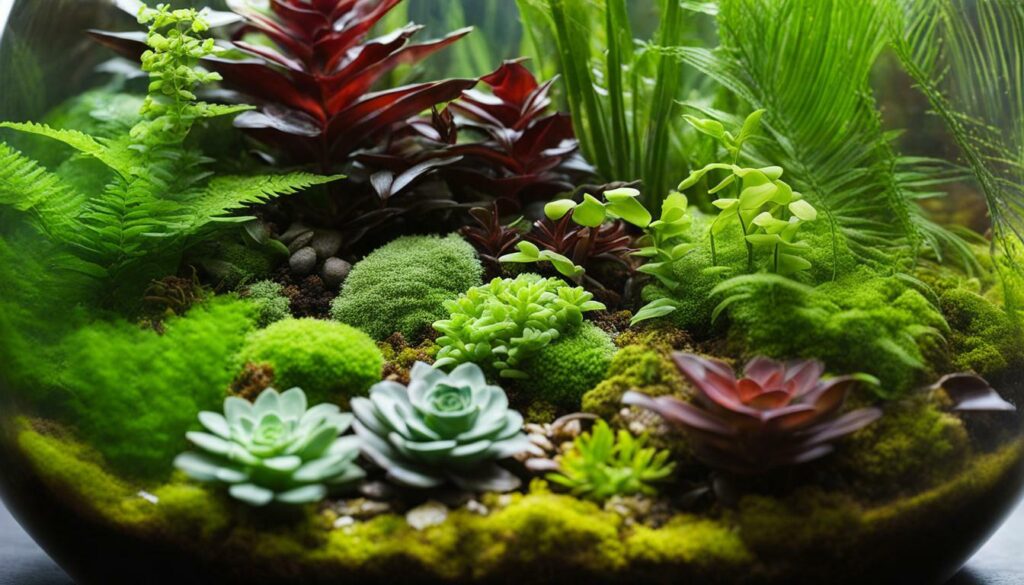
A popular choice for terrarium soil mixes is a combination of organic potting soil, peat moss, and perlite or vermiculite. This mix provides a balanced blend of nutrients, water retention, and drainage. You can also consider adding a layer of activated charcoal at the bottom of your terrarium to help filter out impurities and maintain a fresh environment.
| Soil Recommendations: | Plants Suitable For |
|---|---|
| Cactus/Succulent Mix | Cacti, succulents, and plants that prefer dry conditions |
| Tropical Mix | Tropical plants that require more moisture |
| Orchid Mix | Orchids and epiphytic plants |
| Peat-Based Mix | Carnivorous plants that thrive in acidic conditions |
Remember to monitor the moisture levels in your terrarium and adjust watering accordingly. Overwatering can lead to root rot and other issues, so it’s important to find the right balance. Regularly check the soil’s moisture level by inserting your finger into the soil – if it feels dry, it’s time to water. Maintaining a healthy soil environment is key to the overall well-being of your terrarium plants.
Watering Techniques for Healthy Terrarium Plants
Proper watering techniques are crucial for the overall health and vitality of terrarium plants, as excessive moisture can lead to various problems. Overwatering can result in root rot, fungal growth, and the development of pests. On the other hand, underwatering can cause dehydration, wilting, and stunted growth. To ensure optimal moisture levels, it’s important to follow these guidelines:
- Check the soil moisture: Before watering your terrarium, check the moisture level of the soil. Stick your finger about an inch deep into the soil to gauge its dampness. If it feels dry, it’s time to water. If it feels slightly moist, wait for a few more days.
- Watering frequency: The frequency of watering depends on various factors such as the plant species, humidity levels, and the type of terrarium setup. As a general rule, most terrarium plants require watering once every 1-2 weeks. However, it’s essential to adapt this schedule based on the specific needs of your plants.
- Watering method: When watering your terrarium, it’s best to use a fine mist spray bottle or a watering can with a narrow spout. This will allow you to distribute the water evenly and prevent excessive saturation. Aim to moisten the soil without creating a waterlogged environment.
- Drainage system: To avoid water accumulation and potential root rot, ensure that your terrarium has proper drainage. This can be achieved by layering the bottom of the terrarium with gravel or pebbles, which will help excess water to drain away from the plant roots.
By following these watering techniques, you can maintain the ideal moisture balance for your terrarium plants, promoting their growth and overall well-being.
Table: Recommended Watering Schedule for Popular Terrarium Plants
| Plant Species | Watering Frequency |
|---|---|
| Tropical Ferns | Every 7-10 days |
| Succulents | Every 14-21 days |
| Mosses | Every 3-5 days |
| Pitcher Plants | Every 10-14 days |
Remember, these watering guidelines can serve as a starting point, but it’s important to monitor your plants individually and adjust the schedule based on their specific needs. Keep a close eye on the moisture levels and make modifications as necessary to ensure the health and vitality of your terrarium plants.
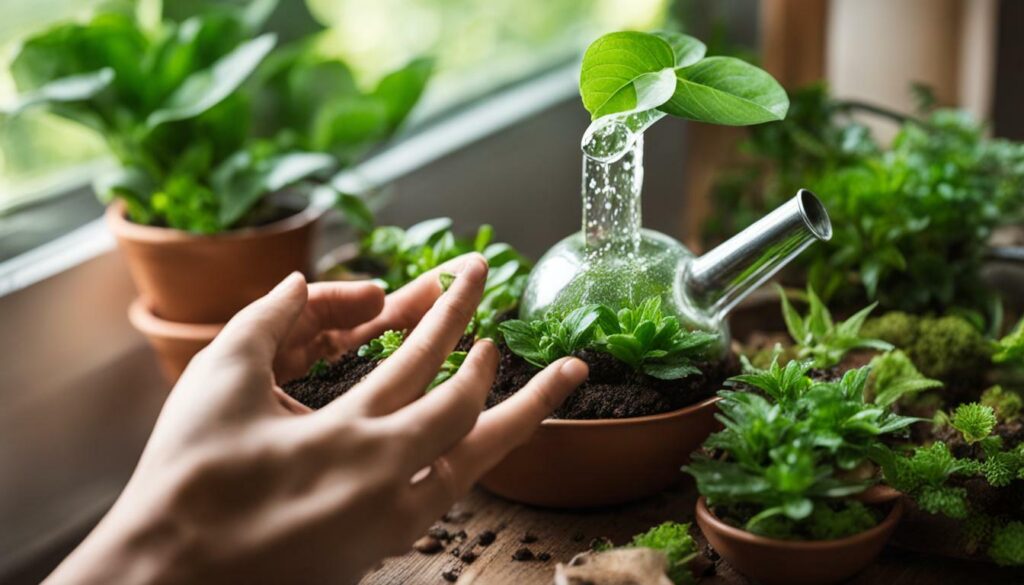
Pruning is an essential aspect of terrarium care, allowing you to control plant growth and enhance the overall appearance of your terrarium. Regular pruning helps maintain a well-balanced ecosystem, prevents overcrowding, and encourages healthier plant growth. Whether you have a lush and dense terrarium or a minimalist setup, pruning is key to achieving the desired aesthetic and ensuring the well-being of your plants.
When pruning your terrarium plants, it’s important to use sharp pruning shears to make clean cuts. Before using them, remember to clean and disinfect the shears to prevent the spread of any potential diseases or pests. It is recommended to disinfect the blades with rubbing alcohol or a bleach solution and wipe them dry before use.
When deciding which parts to prune, focus on removing any dead or damaged leaves, stems, or flowers. You can also selectively prune to shape your plants and keep them at a manageable size. Avoid removing more than 10% of the leaves in one go to minimize stress on the plants. By regularly monitoring your plants and pruning as needed, you can create a visually appealing terrarium that thrives.
Benefits of Pruning
- Controls plant growth and prevents overcrowding
- Improves air circulation and reduces the risk of fungal diseases
- Enhances the aesthetic appeal of your terrarium
- Removes dead or damaged parts to promote healthier growth
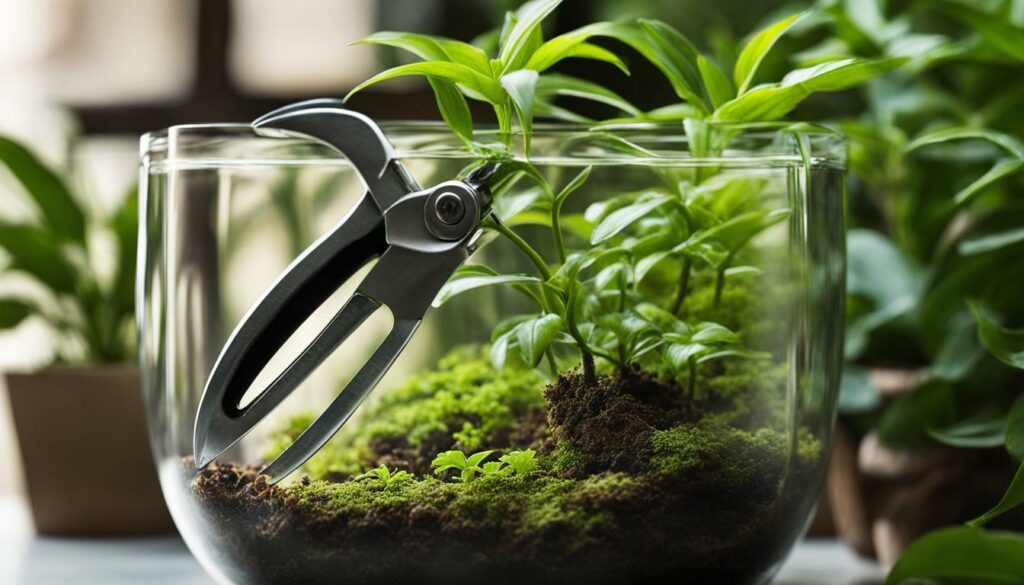
Remember, when pruning, always consider the specific needs of your plants and the overall environment of your terrarium. Each plant may have different pruning requirements, so it’s important to research and understand the specific needs of your plant species. By mastering the art of pruning, you can ensure that your terrarium remains healthy, vibrant, and visually stunning.
| Key Points | Benefits |
|---|---|
| Controls plant growth | Prevents overcrowding |
| Improves air circulation | Reduces risk of diseases |
| Enhances aesthetic appeal | Creates visually stunning terrarium |
| Removes dead or damaged parts | Promotes healthier growth |
Ensuring Clean Leaves for Optimal Plant Health
Clean leaves are essential for the proper functioning of terrarium plants, ensuring they can effectively absorb sunlight and exchange gases. Regular cleaning and maintenance of the leaves can prevent the buildup of dust, dirt, and pests, allowing the plants to thrive in their enclosed environment.
To clean the leaves of your terrarium plants, misting with distilled water is usually sufficient. Simply spray a light mist on the leaves, ensuring that the water reaches both the top and bottom surfaces. For larger plants or those with hardier leaves, you may need to gently wipe the leaves with a moistened microfiber cloth. This helps remove any stubborn dirt or residue and keeps the leaves clean and healthy.
It’s important to avoid using any cleaning agents or chemicals on the leaves, as these can be harmful to the plants. Stick to using distilled water or natural solutions, such as a mild soap diluted in water, if necessary. Always test any cleaning solution on a small, inconspicuous area of the plant first to ensure it does not cause any damage.
Regularly inspect the leaves of your terrarium plants for any signs of pests, such as aphids or spider mites. If you notice any infestation, isolate the affected plant and take appropriate measures to eliminate the pests. This may involve using natural pest control methods, like introducing predatory insects or applying organic insecticidal soap.
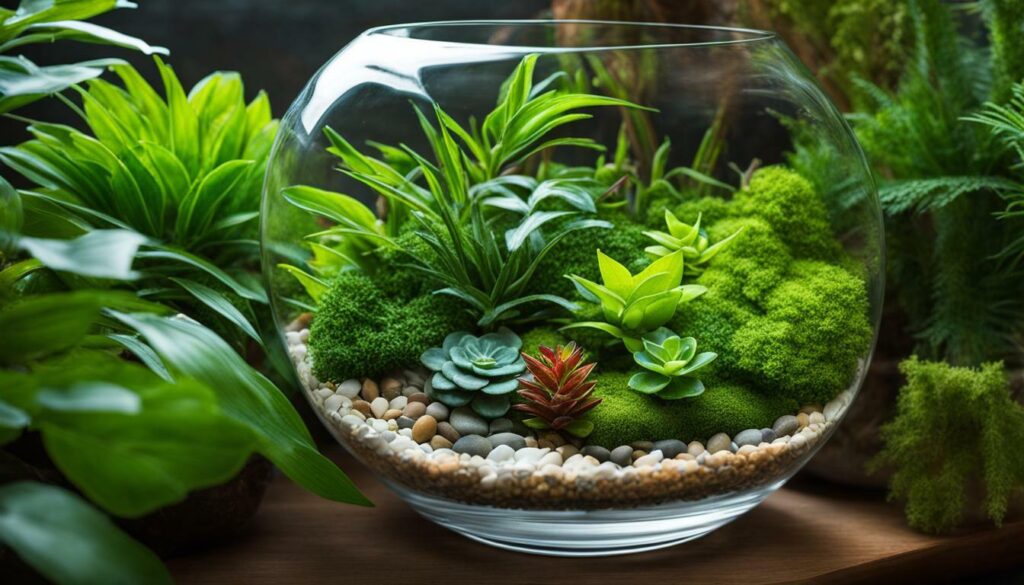
Keeping the leaves of your terrarium plants clean not only enhances their visual appeal but also contributes to their overall health and vitality. By incorporating regular leaf cleaning into your terrarium maintenance routine, you can ensure that your plants receive the optimal conditions they need to thrive in their enclosed ecosystem.
Choosing Compatible Plants for Your Terrarium
Selecting the right plants for your terrarium is crucial for their long-term health and compatibility with your pet’s habitat. When choosing plants, consider factors such as light, humidity, and grazing habits to create an ecosystem that supports the well-being of both your plants and your pet.
In low to medium light terrariums, opt for plants that thrive in these conditions. Some popular choices include ferns, pothos, fittonia, and bromeliads. These plants are known for their ability to tolerate lower light levels, making them suitable for terrarium environments. Additionally, they add a touch of greenery and enhance the aesthetics of your terrarium.
Humidity is another important factor to consider when selecting plants. Some species that do well in high humidity terrariums include orchids, begonias, and air plants. These plants not only thrive in humid conditions but also contribute to the overall moisture balance of your terrarium. Remember to monitor the humidity levels regularly and make adjustments as necessary to ensure the well-being of your plants.
Grazing habits of your pet should also be taken into account when choosing plants for your terrarium. If you have a herbivorous pet, select plants that won’t be excessively grazed on. A balance should be struck to ensure that your pet has enough to eat without causing damage to the plants. Some suitable plants for herbivorous pets include spider plants, hibiscus, and wandering jew. These plants provide a source of grazing while still maintaining their overall health.
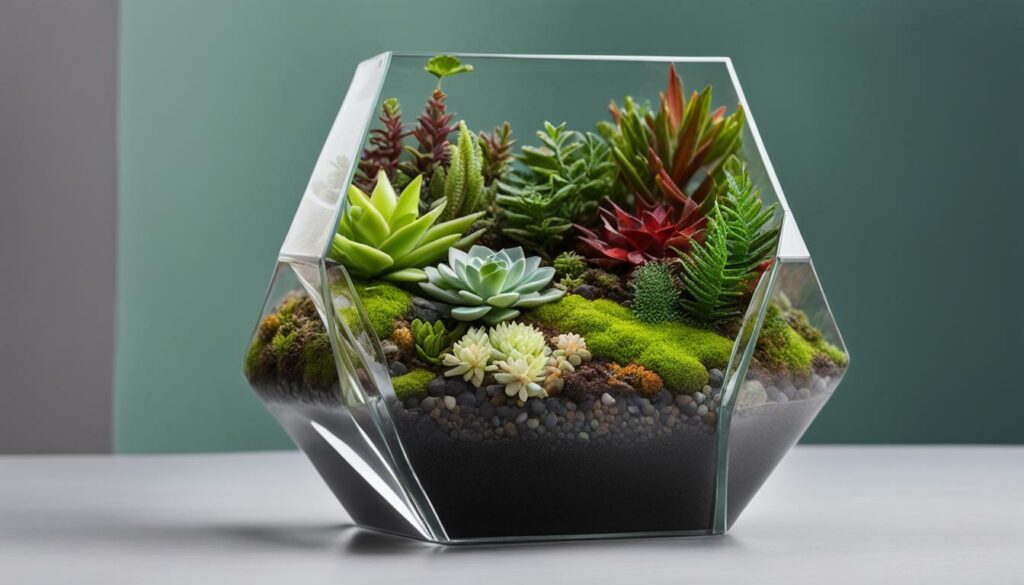
| Plant | Light Requirements | Humidity Preferences | Grazing Suitability |
|---|---|---|---|
| Ferns | Low to medium light | High humidity | Not heavily grazed on |
| Pothos | Low to medium light | Moderate humidity | Not heavily grazed on |
| Fittonia | Low to medium light | High humidity | Not heavily grazed on |
| Bromeliads | Low to medium light | Moderate to high humidity | Not heavily grazed on |
| Orchids | Low to medium light | High humidity | Not heavily grazed on |
| Begonias | Low to medium light | High humidity | Not heavily grazed on |
| Air plants | Low to medium light | High humidity | Not heavily grazed on |
| Spider plants | Low to medium light | Moderate humidity | Suitable for grazing |
| Hibiscus | Medium to bright light | Moderate humidity | Suitable for grazing |
| Wandering jew | Medium to bright light | Moderate humidity | Suitable for grazing |
By carefully selecting compatible plants for your terrarium, you can create an environment that supports both the health of your plants and the well-being of your pet. Remember to monitor the conditions regularly and make any necessary adjustments to ensure the longevity of your terrarium ecosystem.
Mastering Terrarium Care: Fertilization Schedule
A well-executed fertilization schedule is key to maintaining optimal nutrient levels and promoting the health and growth of your terrarium plants. Each plant species has unique nutritional requirements, and providing them with the right balance of fertilizer is essential for their well-being. By following a fertilization schedule, you can ensure that your plants receive the necessary nutrients to thrive.
To create a fertilization schedule, start by determining the specific needs of your terrarium plants. Research the nutritional requirements of each plant species and take into account factors such as light, water, and soil conditions. This will help you tailor your fertilization schedule to meet the individual needs of each plant.
When choosing a fertilizer for your terrarium, opt for herp-safe options that are formulated specifically for use with reptiles and amphibians. These fertilizers are free from harmful chemicals that could be toxic to your pets. Additionally, consider using slow-release fertilizers, which provide a steady supply of nutrients over a longer period of time.
Remember to monitor your plants closely for signs of nutrient deficiencies or excesses. Symptoms such as yellowing leaves, stunted growth, or leaf burn can indicate an imbalance in nutrient levels. Adjust your fertilization schedule accordingly to address any deficiencies or excesses and ensure that your plants remain healthy.
Sample Fertilization Schedule:
| Plant Species | Fertilization Frequency | Recommended Fertilizer |
|---|---|---|
| Succulents and Cacti | Every 2 months | Cactus fertilizer (diluted to half strength) |
| Tropical Ferns | Every 4 weeks | General-purpose liquid fertilizer (diluted to half strength) |
| Mosses and Ground Covers | Every 8 weeks | Organic liquid fertilizer (diluted to half strength) |
Remember to always follow the manufacturer’s instructions when applying fertilizer to your terrarium. Over-fertilization can be harmful to your plants, so it’s important to use the correct dosage and frequency.
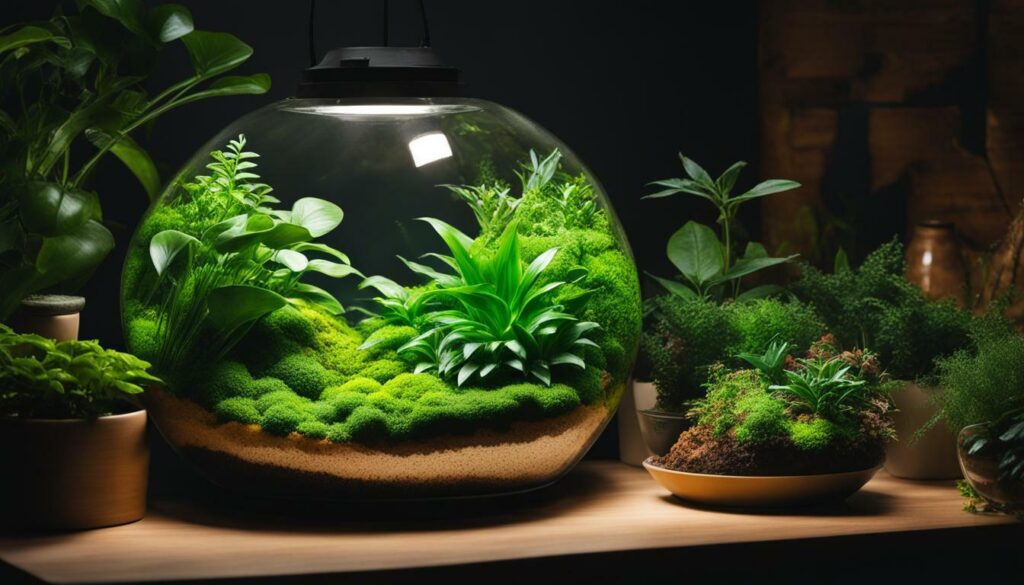
By implementing a well-planned fertilization schedule, you can ensure that your terrarium plants receive the necessary nutrients for healthy growth. Keep in mind the specific needs of each plant species, choose herp-safe fertilizers, and regularly monitor your plants for signs of nutrient deficiencies or excesses. With proper fertilization, your terrarium will flourish, creating a beautiful and vibrant ecosystem.
The Importance of Routine Terrarium Maintenance
Routine maintenance is vital for the overall well-being of your terrarium, ensuring its longevity and the health of its inhabitants. By following a regular maintenance schedule, you can prevent potential issues and create a thriving environment for your plants and pets.
To help you stay organized, here are some key tasks to include in your routine maintenance:
- Clean the terrarium: Regularly remove any debris, dead leaves, or uneaten food to maintain a clean and hygienic environment. This helps prevent the buildup of harmful bacteria and mold.
- Check for pest infestations: Inspect your terrarium regularly for signs of pests, such as tiny insects, webs, or chewed leaves. If you notice any infestations, take appropriate measures to eliminate the pests and protect your plants.
- Trim and prune plants: Promote healthy growth and maintain the aesthetics of your terrarium by trimming and pruning your plants as needed. Remove any yellow or dying leaves, and trim overgrown branches to ensure proper air circulation and light penetration.
- Monitor humidity and temperature levels: Keep an eye on the humidity and temperature levels in your terrarium, as they play a crucial role in the well-being of your plants and pets. Adjust these levels as needed to provide an optimal environment.
- Inspect plant health: Regularly check your plants for any signs of disease or nutrient deficiencies. Look for discoloration, wilting, or unusual growth patterns. If you notice any issues, take appropriate action, such as adjusting fertilization or addressing nutrient imbalances.
By incorporating these maintenance tasks into your routine, you can ensure the long-term health and success of your terrarium. Remember to observe your plants and pets closely, as they may have specific needs that require additional attention. With proper care and regular maintenance, your terrarium will continue to thrive and bring joy to your space.
| Maintenance Task | Frequency |
|---|---|
| Cleaning | Weekly |
| Pest Inspection | Weekly |
| Trimming and Pruning | As needed |
| Humidity and Temperature Monitoring | Daily |
| Plant Health Check | Weekly |
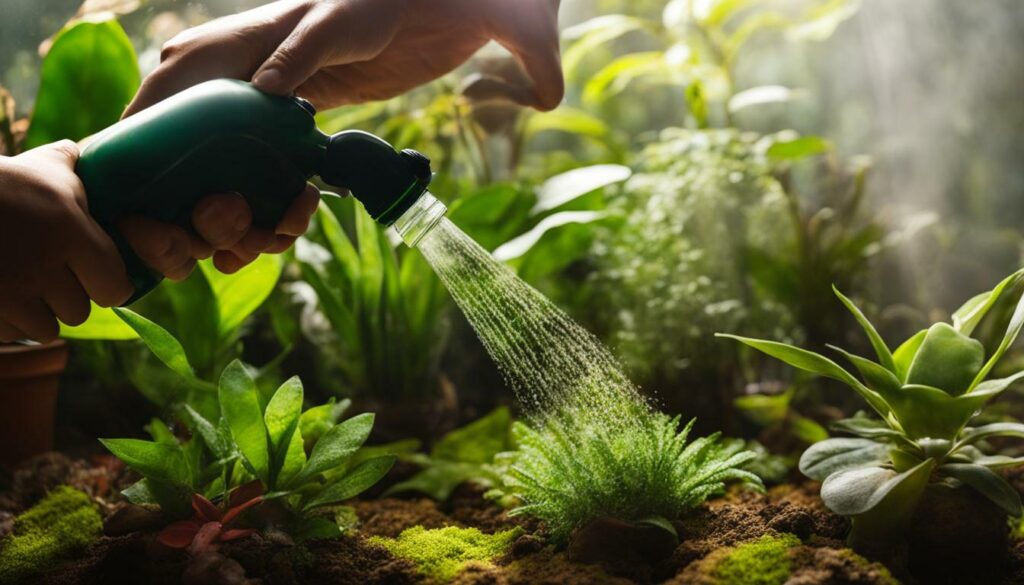
What is the Best Fertilization Schedule for Terrarium Care?
When it comes to fertilizing terrarium best practices, it’s important to find a schedule that works for your specific plants. Typically, a monthly or bi-monthly feeding with a diluted liquid fertilizer during the growing season is sufficient. However, always monitor your plants for any signs of overfeeding or nutrient deficiencies.
Creating an Ideal Terrarium Ecosystem
By meticulously considering all aspects of terrarium care, you can create an ideal ecosystem that fosters the health and vibrancy of your terrarium plants. This involves optimizing various factors such as lighting, soil, water, pruning, cleanliness, and plant selection. Let’s explore each of these elements in detail. Lighting: Providing the right amount of light is crucial for the growth and well-being of your terrarium plants. Ensure that your plants receive adequate light by placing them in a suitable location where they can receive indirect sunlight or by using artificial grow lights if needed. Consider the specific light requirements of your plants and adjust the lighting accordingly. Soil: Choosing the right soil for your terrarium plants is essential. Opt for a well-draining soil mix that retains moisture but also allows excess water to drain away. Adding organic matter such as compost or peat moss can help improve soil fertility and texture. Research the soil preferences of your plants to ensure they have the ideal growing conditions. Watering: Proper watering techniques are crucial to maintain optimal moisture levels in your terrarium. Avoid overwatering, as it can lead to root rot and other plant health issues. Water your plants sparingly, ensuring the soil is dry before each watering. It’s important to monitor the moisture levels regularly and adjust watering frequency based on the specific needs of your plants. Pruning: Regular pruning helps control plant growth and keeps your terrarium looking tidy. Remove any dead, damaged, or overcrowded leaves and stems to promote airflow and prevent the spread of diseases. Use clean and sterilized pruning shears to avoid transmitting any pathogens. Pruning also allows you to shape your plants and create a visually pleasing arrangement. Keeping your terrarium clean is essential for the overall health of your plants. Regularly remove any dead leaves, debris, or pests that may have accumulated. Wipe the leaves gently with a damp cloth to remove dust and maintain their ability to absorb sunlight. Cleanliness helps prevent the growth of mold and other harmful organisms.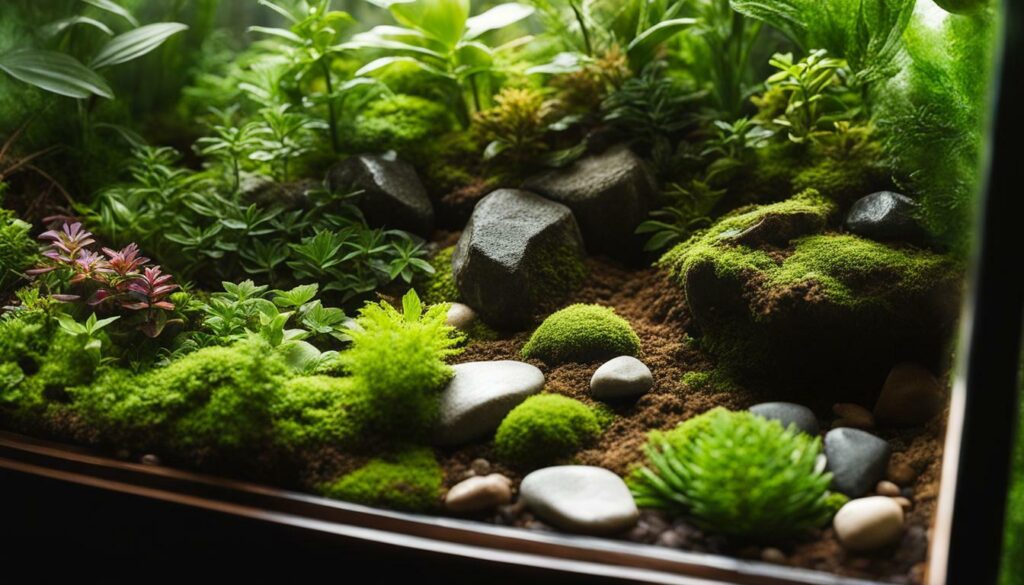 By following these guidelines and considering the important aspects of terrarium care, you can create an ideal ecosystem that promotes the growth and vitality of your plants. Remember to monitor your terrarium regularly, make adjustments as needed, and enjoy the beauty and tranquility of your thriving terrarium.
By following these guidelines and considering the important aspects of terrarium care, you can create an ideal ecosystem that promotes the growth and vitality of your plants. Remember to monitor your terrarium regularly, make adjustments as needed, and enjoy the beauty and tranquility of your thriving terrarium.
By implementing a well-planned fertilization schedule and mastering terrarium care, you can enjoy thriving plants and a vibrant terrarium ecosystem all year round. Terrarium care is all about understanding the individual needs of your plants. Light plays a crucial role in plant growth, so make sure to adjust the lighting according to your plants’ specific requirements while considering your pet’s needs.
Soil is another important aspect of terrarium care. It acts as a foundation for plant growth and provides essential nutrients and water. Choosing the right soil for your plants is crucial for their well-being. While a bioactive setup can provide sufficient nutrients, imbalances can occur. Adding herp-safe fertilizers or occasionally removing waste and replacing substrate can help maintain soil health.
Watering your terrarium plants is essential, but it’s important to avoid overwatering. Only water the plants when the soil is dry and remove any excess water to prevent root rot. Don’t forget to consider your pet’s humidity needs when adjusting moisture levels.
Pruning is necessary to control plant growth, improve ventilation, and maintain the overall health and aesthetics of your terrarium. Use sharp pruning shears and avoid removing more than 10% of the leaves at once. Regular pruning can also help shape the plants to better suit your pet’s habitat.
Keeping the leaves clean is crucial for optimal plant health. Misting with distilled water or gently wiping larger plants with a moistened microfiber cloth can help remove dust and debris, allowing the plants to absorb sunlight and exchange gases effectively.
When selecting plants for your terrarium, choose ones that are compatible with your pet’s habitat and can thrive in the available light and humidity levels. Avoid plants that grow too fast or have large leaves that can overshadow others.
Mastering terrarium care and creating a fertilization schedule involves understanding the specific needs of your plants and providing optimal care in terms of light, soil, water, pruning, and cleanliness. With proper care, you can ensure the long-term health and beauty of your terrarium ecosystem.
FAQ
What are the signs of too much light for terrarium plants?
Signs of too much light include wilting, curled leaves, and brown spots.
What are the signs of insufficient light for terrarium plants?
Signs of insufficient light include sparse growth and undersized leaves.
How should I adjust the lighting in my terrarium?
Adjust the lighting in your terrarium according to the specific needs of your plants while considering your pet’s needs as well.
What role does soil play in terrarium care?
Soil provides a foundation for plant growth and acts as a reservoir for water and nutrients.
How can imbalances in soil occur in a terrarium?
Imbalances in soil can occur due to nutrient deficiencies or excesses. Adding a herp-safe fertilizer or occasionally removing waste and replacing some substrate can help maintain soil health.
How often should I water terrarium plants?
Water the plants only when the soil is dry and there is no condensation on the terrarium walls. Avoid overwatering as it can lead to root rot.
How should I prune terrarium plants?
Use sharp pruning shears to remove damaged leaves and stems. Prune regularly to control growth, improve ventilation, and maintain the health and aesthetics of your terrarium.
How should I clean the leaves of terrarium plants?
Misting with distilled water is usually sufficient for cleaning, but larger plants may require gentle wiping with a moistened microfiber cloth.
What factors should I consider when choosing plants for my terrarium?
Choose plants that thrive in low to medium light, tolerate humidity, and won’t be grazed on excessively by your pet. Avoid fast-growing plants or those with large leaves that can overshadow smaller plants.
What is the importance of creating a fertilization schedule for terrarium plants?
A fertilization schedule helps maintain nutrient balance in the terrarium, ensuring the health and growth of the plants.
Why is routine maintenance important for terrariums?
Routine maintenance helps prevent imbalances, keeps the terrarium clean and healthy, and ensures the longevity of the terrarium ecosystem.
What is the overall goal of mastering terrarium care?
The overall goal is to create an ideal terrarium ecosystem by optimizing lighting, soil, water, pruning, cleanliness, and plant selection, and ensuring the health and longevity of the terrarium.

